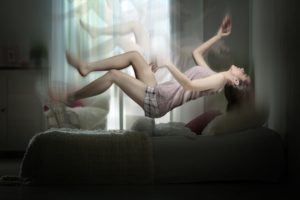Exploding Head Syndrome
Exploding head syndrome (EHS) is a parasomnia sleep disorder defined by episodes that typically occur during the transition period between sleep and wakefulness. These episodes feature imagined sounds or sensations that create the perception of a loud explosion and possibly a flash of light, in the sleeper’s head. The episodes are brief, usually lasting less than a second.
Although this disorder is not associated with physical pain, people may feel frightened or anxious after the episode subsides. Those who experience more than one episode during the course of a single night may also experience strong arousal that can lead to sleep loss.
Symptoms of Exploding Head Syndrome
According the International Classification of Sleep Disorders, patients must meet all of the following criteria to receive an EHS diagnosis:
1. Complaints of loud noises or sensations that mimic the effects of an explosion in the head during transition periods between sleep and wakefulness.
2. Feelings of intense arousal, and possibly fright, following these episodes.
3. No significant physical pain during or following the episodes.
Although not part of the diagnostic criteria, some people perceive flashes of light during their EHS episodes. Myoclonic jerks — involuntary twitches that affect groups of muscles — may also occur.
What Causes Exploding Head Syndrome?
Although EHS has been documented since the 1870s, the disorder has not been extensively studied and the prevalence rate is not known. Research suggests EHS occurs more commonly in women than men. The median age for all reported cases is 58, but cases have been reported with patients ranging from younger than 10 to older than 80. Some EHS cases involve two or more members of the same family, but a genetic link has not officially been established.
The frequency of episodes varies by patient. Some experience multiple episodes over the course of one night. Patients have also reported repeated episodes over several consecutive nights following weeks or months of complete inactivity.
In most cases, patients don’t notice any precipitating factors leading up to EHS episodes. That said, some claim to experience a greater number of episodes when they are stressed or tired. Feelings of fright immediately following EHS episodes are common, as are physiological signs of fear such as sweating, palpitations, and difficulty breathing.
A 2020 survey of 3,286 individuals with EHS — to date, the largest sample studied for the disorder — found roughly 44% of patients experience “significant fear” upon waking up. Recurring attacks can also lead to clinical distress, particularly if the patient has worries or concerns about a more serious underlying condition.
Is Exploding Head Syndrome Dangerous?
EHS is considered a harmless condition that does not pose a danger to one’s health. In fact, primary management of the disorder includes education and reassurances about its benign nature. Some people even experience fewer EHS episodes after hearing this information.
Most people diagnosed with EHS will receive a good prognosis. The disorder is not associated with any additional conditions that consequently occur. With proper treatment and time, EHS episodes may completely disappear.

Diagnosis and Treatment
There are no objective tests used to diagnose EHS. However, diagnostic criteria can help doctors distinguish EHS from conditions that produce similar symptoms.
For example, sudden onset-headache syndromes, like idiopathic stabbing headaches and thunderclap headaches, also cause episodes that occur without warning. Pain often accompanies these episodes and they commonly occur during the waking hours. Other conditions EHS patients may be evaluated for include nocturnal epilepsy, hypnic headaches, and post-traumatic stress disorder.
Since EHS does not appear to affect sleep duration or architecture, some patients undergo polysomnography tests or magnetic resonance imaging to check for underlying conditions. Physicians often ask patients about other sleep disorders and medical or psychiatric conditions. Studies suggest a strong link between EHS and insomnia, as well as sleep paralysis, but more research is needed.
EHS is normally treated without medication. While there is no record of a research or clinical trial exploring drug treatment options for the disorder, some medications have reportedly been effective at alleviating symptoms.

Still have questions? Ask our community!
Join our Sleep Care Community — a trusted hub of sleep health professionals, product specialists, and people just like you. Whether you need expert sleep advice for your insomnia or you’re searching for the perfect mattress, we’ve got you covered. Get personalized guidance from the experts who know sleep best.
References
2 Sources
-
National Institute of Neurological Disorders and Stroke. (2023, January 20). Myoclonus., Retrieved April 14, 2023, from
https://www.ninds.nih.gov/health-information/disorders/myoclonus -
Sharpless, B. A., Denis, D., Perach, R., French, C. C., & Gregory, A. M. (2020). Exploding head syndrome: Clinical features, theories about etiology, and prevention strategies in a large international sample. Sleep Medicine, 75, 251–255.
https://pubmed.ncbi.nlm.nih.gov/32862013/













